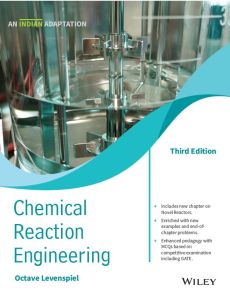Chemical Reaction Engineering, 3ed (An Indian Adaptation)
ISBN: 9789354244605
860 pages
For more information write to us at: acadmktg@wiley.com

Description
Levenspiels' Chemical Reaction Engineering has been designed as an introductory textbook for the undergraduate course in the domain. The text written in student-friendly style, helps students learn how to answer reactor design questions and develop a strong intuitive sense for good design. It builds on concepts progressively, with appropriate emphasis on assumptions made, why an alternative approach is not used, and to indicate the limitations of the treatment when applied to real situations. The Indian Adaptation of Chemical Reaction Engineering, Third Edition, is restructured at places and offers new and updated material to provide complete coverage of the course as per Indian curriculum.
Notation
Chapter 1
Introduction to Chemical Reaction Engineering
Part I Homogeneous Reactions in Ideal Reactors
Chapter 2 Kinetics of Homogeneous Reactions
2.1 Concentration-Dependent Term of a Rate Equation
2.2 Temperature-Dependent Term of a Rate Equation
2.3 Searching for a Mechanism
2.4 Predictability of Reaction Rate from Theory
Chapter 3 Interpretation of Batch Reactor Data
3.1 Constant-Volume Batch Reactor
3.2 Varying-Volume Batch Reactor
3.3 Temperature and Reaction Rate
3.4 The Search for a Rate Equation
Chapter 4 Introduction to Reactor Design
4.1 General Discussion
Chapter 5 Ideal Reactors for a Single Reaction
5.1 Ideal Batch Reactor
5.2 Steady-State Mixed Flow Reactor
5.3 Steady-State Plug Flow Reactor
5.4 Semibatch Reactor
Chapter 6 Design for Single Reactions
6.1 Size Comparison of Single Reactors
6.2 Multiple-Reactor Systems
6.3 Recycle Reactor
6.4 Autocatalytic Reactions
Chapter 7 Design for Multiple Reactions
7.1 Design for Parallel Reactions
7.2 Design for Series Reactions
7.3 Successive Irreversible Reactions of Different Orders
7.4 Reversible Reactions
7.5 Irreversible Series-Parallel Reactions
7.6 The Denbigh Reactions and Their Special Cases
Chapter 8 Design for Nonisothermal Reactors
8.1 Temperature and Pressure Effects in Single Reactions
8.2 Nonisothermal Reactors
8.3 General Graphical Design Procedure for Single Reactions
8.4 Adiabatic Reactors
8.5 Exothermic Reactions in Mixed Flow Reactors—A Special Problem
8.6 Multiple Reactions
8.7 Summary of Balance Equations
Chapter 9 Selection of Reactor
Part II Flow Pattern, Contacting, and Non-Ideal Flow
Chapter 10 Basics of Non-Ideal Flow
10.1 E, The Age Distribution of Fluid, the RTD
10.2 Conversion in Non-Ideal Flow Reactors
Chapter 11 Compartment Models
Chapter 12 The Dispersion Model
12.1 Axial Dispersion
12.2 Correlations for Axial Dispersion
12.3 Chemical Reaction and Dispersion
Chapter 13 The Tanks-in-Series Model 411
13.1 Pulse Response Experiments and the RTD
13.2 Chemical Conversion
Chapter 14 The Convection Model for Laminar Flow
14.1 The Convection Model and its RTD
14.2 Chemical Conversion in Laminar Flow Reactors
Chapter 15 Earliness of Mixing, Segregation, and RTD
15.1 Self-Mixing of a Single Fluid
15.2 Mixing of Two Miscible Fluids
Part III Reactions Catalyzed by Solids
Chapter 16 Heterogeneous Reactions—Introduction
Chapter 17 Solid Catalyzed Reactions
17.1 The Rate Equation for Surface Kinetics
17.2 Pore Diffusion Resistance Combined with Surface Kinetics
17.3 Porous Catalyst Particles
17.4 Heat Effects During Reaction
17.5 Performance Equations for Reactors Containing Porous Catalyst Particles
17.6 Experimental Methods for Finding Rates
17.7 Product Distribution in Multiple Reactions
Chapter 18 The Packed Bed Catalytic Reactor
Chapter 19 Reactors with Suspended Solid Catalyst, Fluidized Reactors of Various Types
19.1 Background Information About Suspended Solids Reactors
19.2 The Bubbling Fluidized BED–BFB
19.3 The K–L Model For BFB
19.4 The Circulating Fluidized BED–CFB
19.5 The JET Impact Reactor
Chapter 20 Deactivating Catalysts
20.1 Mechanisms of Catalyst Deactivation
20.2 The Rate and Performance Equations
20.3 Design
Chapter 21 G/L Reactions on Solid Catalysts: Trickle Beds, Slurry Reactors

